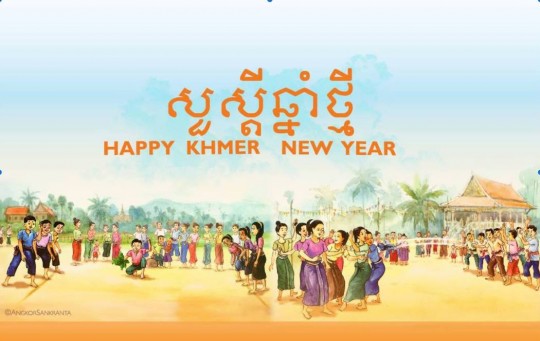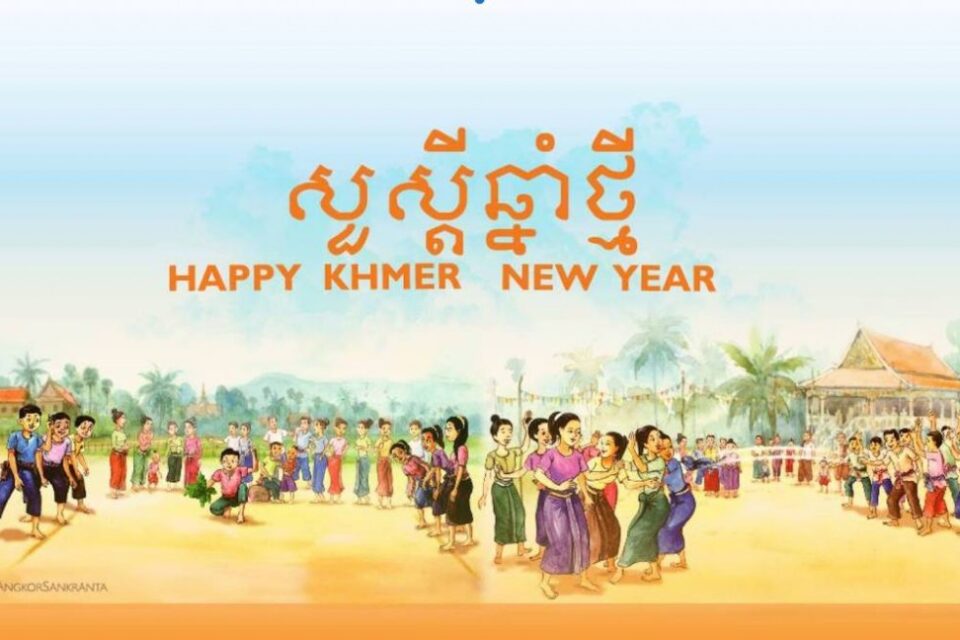Khmer New Year, also known as “Choul Chnam Thmey,” meaning entering the new year, is a national holiday hosted by Cambodians annually. It is the season when Cambodians have free time from harvesting rice and other agricultural commodities. The event is Cambodia’s largest event and lasts three days, on the 13th, 14th, or 15th of April (in a specific year, it could be on the 14th to 16th of April).

Cambodian New Year is celebrated just like other Asian New Year Festivals that blend history with religious practices, emphasizing and commemorating the seniors and ancestors. While there are merriments with traditional meals and beverages, the three days are packed with Buddhist compliance centered on performing gratitude, sending offerings to deceased family members, and contributing to those in need. The following preparations are exclusively made for the Khmer New Year.
Day 1: Maha Songkran
People clean their houses, and every single corner is checked. Each household displays flowers, lighting, delightful foods, fresh produce, traditional Khmer cuisines, and canned beverages for the interior altar and the spirit palace. Generally, the spirit palace stands outside a roofed shrine; it rests on a pedestal in front of a Cambodian’s house. Most Cambodians believe that this palace stands for the family’s protecting spirit.
On the first day of the Khmer New Year, it is known as Sankranti or Moha Sangkrant in Khmer. Cambodians embellish their houses with plentiful decorations and brilliant illumination for this special event. More importantly, the common preparation may include a water basin with flowers, usually jasmine, 5 incense, 5 candles, sticks, flowers, desserts, fruits, drinks, and other items of choice.
At the designated hour for the angel of the year, people will then pay tribute in their houses by burning candles and incense, praying the angel will bless them with happiness, prosperity, and serenity during the year. According to the legends, on Moha Sangkran, there are seven different angels, and the one who presents for each year is determined by the day of the week. On top of that, some families also pray the Dharma on the first day to greet the angel into their house; meanwhile, the culinary is also prepared and brought to the local pagoda or Khmer temple for the monks.
Day 2: Virak Vanabat
The second day of the Khmer New Year is called “Virak Vanabat” in Khmer. Locals visit the Buddhist pagodas to present refreshments, desserts, fruits, and flowers to the monks. Likewise, Cambodian families always gather at temples to commemorate their ancestors. Furthermore, they donate money, food, and stuff to the underprivileged based on what they can afford. Other fun activities include:
- Playing Khmer traditional games, such as tossing the towel known as “Chol Chhoung“
- Scarf Hidden Game is called “Leak Kon Saeng“
- Catching the baby hawk meant “Chab Kon Kleng“
- Tugging Game or “Teanh Proat”
- Bos AngKunh
- Lout Bav or Jumping Bag Game (ល្បែងលោតបាវ)
- Pong Raot Koun Kromom Game (ល្បែងពង្រាត់កូនក្រមុំ)
- Veay K’aom or Hit the Earthen Pot Game (ល្បែងវាយក្អម)
- and many more Khmer traditional folk games
- Dancing and singing happy-classical Khmer songs at pagodas and other locations across the country.
Day 3: Vearak Loeng Sak
On the third day or Virak Loeng Sak, Cambodians use holy fragrant water to cleanse Buddha statues and their elders. Bathing the Buddha statues is a ceremonial ritual that locals believe washes away the sadness, sorrow, and sinful behaviors, replicating how clean water can wash the dirty things. This aspect is also regarded as a genuine act that will grant blessing, contentment, and wealth in life. Furthermore, by washing their elderly family members, including parents, grandparents, and elders, the children may acquire great joy, wishes, and tremendous direction for the year ahead. It is also the concluding day of the Khmer New Year celebration.
The Year’s Biggest Event in Cambodian Tradition
Paying tributes to the deceased during Khmer New Year became an even more prominent event after the Khmer Rouge rule, which is historically one of the most notorious human genocides. As a result, Khmer New Year is a great way to realize the importance of the new year celebration, civilization, heritage, customs, and beliefs. Here are three things you should know about this significant event that will undoubtedly urge you to visit Cambodia as soon as possible.
1. In April, It Is ideal.
Early on, Khmer New Year was held on the first lunar month, often in November or December. Nevertheless, during the Angkor Era in the 13th century, the Khmer King modified the date of the new era, which coincided with the fifth Khmer month of the lunar calendar, designing the new date of April. Thus, the Khmer new year marks the harvesting period’s conclusion but occurs before the rainy season. As it turns out, this alteration has become handy for then and now, since November to March is the peak season for farmers.
2. It Is The Feast Season!
During the three days of the New Year, families always prepare delicious traditional food–not just for those still living and feasting, but also as honors to their forebears.
For instance, “Nom Ansom” is one of the most cherished foods and is often served as a sweet sticky rice dessert, but it can be extra savory when cooked with banana or bacon. In addition, the bacon version may include nuts and salted egg filling. Another iconic food is “Khmer curry,” made with numerous herbal ingredients. This common dish can be seen at the majority of traditional Khmer events.
“Khmer Fish Amok” is also a prevalent recipe served and offered during the New Year. Besides, you can find other awe-inspiring foods such as “Kralan,” a tasty glutinous rice cake made with coconut milk and nuts that are packed inside bamboo pieces, steamed and then roasted, and “Ya Hon,” a popular Khmer hot pot.
3. Traditional Games, Competitions, And World Records.
Cambodians can be very creative when they have three days, perhaps four, to occupy themselves with events. Kids, grown-ups, and even seniors participate in the festival activities, including games, competitions, and world records. For example, Cambodia won the world record for “Nom Ansom,” the biggest sticky rice cake ever created in Siem Reap. The heaviest one was 8,906 pounds and 10 ounces. While Khmer New Year has an earnest ambiance, it is a joyous celebration with families, friends, and the whole nation. The final day of the New Year is packed with vibing, fireworks, and street parties throughout Cambodia. Every corner of the country and Khmer people all over the globe put their own twist on this special holiday, making each celebration distinctive in its manner.













